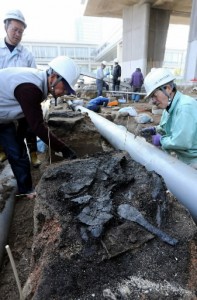Hiroshima Peace Memorial Museum to display layer of excavated soil showing horrors of A-bombing
Mar. 18, 2016
by Kyosuke Mizukawa, Staff Writer
A layer of soil that was the surface of the ground at the time of the atomic bombing has been unearthed through excavation work on the site of the Hiroshima Peace Memorial Museum’s main building. The soil contains many household items such as a charred wooden rice scoop. The City of Hiroshima has decided to preserve this layer, conveying the lives of the people in the former Nakajima area, which was annihilated by the bomb and later transformed into the Peace Memorial Park. On March 7, workers began removing the layer, which will be preserved and exhibited at the museum.
The layer was unearthed from 80 centimeters below the current surface of the ground in the northeastern part of the museum site. In addition to the rice scoop and other items, a charred square metal object was found. The metal object is believed to be a lunch box. The soil of 90 centimeters in length and 60 centimeters in width will be cut off and coated with resin.
The Hiroshima National Peace Memorial Hall for the Atomic Bomb Victims exhibits a cross-section of soil layers, excavated in 1999, which includes the surface of the ground at the time of the atomic bombing. But neither the hall nor the museum holds a full sample of the surface from that time. An official of the Hiroshima City Culture Foundation, which has been entrusted to carry out the excavation by the municipal government, said, “This layer of soil is a symbolic part of the excavation work. I hope it will help people learn how the atomic bomb destroyed people’s lives.”
(Originally published on March 8, 2016)
A layer of soil that was the surface of the ground at the time of the atomic bombing has been unearthed through excavation work on the site of the Hiroshima Peace Memorial Museum’s main building. The soil contains many household items such as a charred wooden rice scoop. The City of Hiroshima has decided to preserve this layer, conveying the lives of the people in the former Nakajima area, which was annihilated by the bomb and later transformed into the Peace Memorial Park. On March 7, workers began removing the layer, which will be preserved and exhibited at the museum.
The layer was unearthed from 80 centimeters below the current surface of the ground in the northeastern part of the museum site. In addition to the rice scoop and other items, a charred square metal object was found. The metal object is believed to be a lunch box. The soil of 90 centimeters in length and 60 centimeters in width will be cut off and coated with resin.
The Hiroshima National Peace Memorial Hall for the Atomic Bomb Victims exhibits a cross-section of soil layers, excavated in 1999, which includes the surface of the ground at the time of the atomic bombing. But neither the hall nor the museum holds a full sample of the surface from that time. An official of the Hiroshima City Culture Foundation, which has been entrusted to carry out the excavation by the municipal government, said, “This layer of soil is a symbolic part of the excavation work. I hope it will help people learn how the atomic bomb destroyed people’s lives.”
(Originally published on March 8, 2016)








